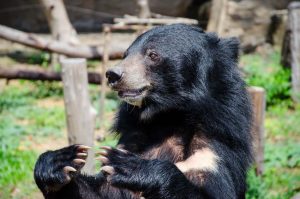Visiting rescue centres and wildlife santuaries should help raise awareness of the human impact on habitats and animal populations.
“On a mission to help animal sanctuaries get exposure for all of the hard work they’re doing.”
.
The Sidmouth Donkey Sanctuary is the area’s largest employer:
Futures Forum: The Donkey Sanctuary
Working at The Donkey Sanctuary: Employee Reviews | Indeed.com
It’s one of the richest charities in the UK – although not the richest:
Pin the cheque on the donkey | Society | The Guardian
And it has a great pull:
East Devon MP pays a visit to Sidmouth’s donkey charity | Sidmouth Herald
Sidmouth open | The Donkey Sanctuary
Most importantly, there’s no question that it does great work:
Safe haven for neglected donkeys after three charities step in – Horsetalk.co.nz
.
There are hundreds of other such ‘sanctuaries’ in the UK and around the world.
But some are more ‘ethical’ than others.
Green and ‘ethical’ groups have asked the right sort of questions:
How Animal ‘Sanctuaries’ Aren’t Always What They Seem – One Green Planet
Are Animal Sanctuaries Ethical? How To Support Conservation & Avoid Exploitation – ETHICAL UNICORN
This has been a subject of academic study:
Captive Wildlife Sanctuaries: Definition, Ethical Considerations and Public Perception
And the mainstream media are very interested too:
How ethical is the elephant ‘sanctuary’ you’re visiting? | Ethical holidays | The Guardian
Are Wildlife Sanctuaries Good for Animals? | nationalgeographic.com
PETA, or ‘people for the ethical treatment of animals’, has an obvious answer to what to look for:
You can easily find answers to these questions by browsing the facility’s website and social media pages before visiting.
How to Tell if a Place Is a REAL Animal Sanctuary | PETA
And even gives a list of places to visit:
Animal-Friendly Vacation Destinations in Asia | PETA Asia
.
 The VGS has just been contacted by Global Grasshopper, “an award-winning blog for independent travelers”:
The VGS has just been contacted by Global Grasshopper, “an award-winning blog for independent travelers”:
Global Grasshopper – travel inspiration for the road less travelled For the road less travelled
It was a specific piece on the VGS news pages which caught thier eye:
“Humanity’s destruction of biodiversity that creates the conditions for new viruses and diseases like COVID-19.”
Bats, disrupted ecosystems and Covid – Vision Group for Sidmouth
In other words, we really do need to be getting real about the human impact on habitats and animal populations.
And perhaps visiting rescue centres and wildlife santuaries will help raise this awareness.
As the note from Global Grasshopper says:
We’re on a mission to help some of our favorite animal sanctuaries get exposure for all of the hard work they’re doing and help travelers find exciting animal sanctuaries to visit.
With a further request:
Could you help us spread the word by sharing this in-depth guide on the best animal sanctuaries to visit around the world?
The guide does indeed look pretty reliable:
One of the first examples on their list is very bona fide – with reports from across the board demonstrating the good work they are carrying out:
Rescue of 101 Bears from Abusive Bile Farm Industry Inspires Film | PEOPLE.com
And here is that film: